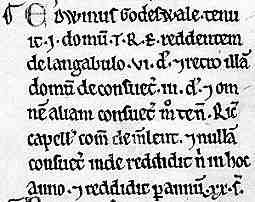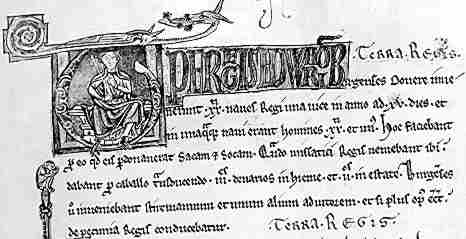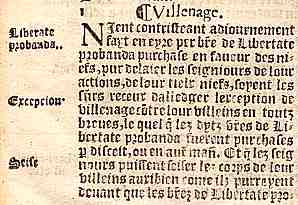




If you are looking at this page without frames, there is more information about medieval writing to be found by going to the home page (framed) or the site map (no frames).
| Domesday Book (2) | ||
| Whatever its practical usefulness, the book was a significant ceremonial object confirming the Norman feudal system of government, whatever any 'Saxon dog' (as they say in the movies) might have thought of the legitimacy of its imposition. The work was written in Latin, the ceremonial language of law and liturgy, and laid out in double columns with enlarged initials in a neat, if heavily abbreviated, Caroline minuscule script. | ||
 |
||
| An enlarged sample of the script of Domesday Book. (From Steffens 1929) | ||
| While Domesday Book does represent a uniquely comprehensive piece of historical evidence, it has certain problems, some of which existed right from the time of its construction. The commisioners translated into Latin a whole range of terms from a variety of vernacular sources; English dialects, Danish and Norse. Some of these terms can be a bit obscure. Measures of land such as hides and carucates were different, and had different relationships, in various parts of the country. Distances and land measurements were not systematically surveyed, but taken from the oral testimony of witnesses. | ||
 |
||
| Land measurements were based on the area of land which could be worked by a plough team. That could vary with land and soil conditions. | ||
| There is a little discussion of this in the Weights, Measures and Money section. | ||
| The commissioners worked topographically, taking each shire and progressing around the vills and hundreds into which the Anglo-Saxon system divided them and under which the old system of royal taxation, Danegeld, had been levied. The work was then presented in terms of the Norman feudal system based on manors and the landholdings of tenants in chief. These did not necessarily bear any relationship to the former, but did relate to various ways in which the Norman kings were able to require their subjects to support them. Essentially Domesday Book muddles together two ways of looking at land, and two systems of generating taxes. | ||
| That early Norman period represented interesting times, as the cliche goes. The information in Domesday Book rapidly went out of date as feudal tenants, not to mention kings, changed, sometimes in unruly circumstances. During the time of Henry I and Henry II there were various regional surveys undertaken to attempt to update the information. The term Domesday has been applied to them, as in the Winton Domesday, a volume containing two surveys of Winchester. |
 |
|
| An entry from the first survey in the Winton Domesday, made between 1103 and 1115 (London, Society of Antiquaries MS 154, f.1). (From New Palaeographical Society 1911) | ||
| Another example of an attempt to update the Domesday data is represented by a manuscript volume of c.1160-70, known as Balliol MS 350, which is a faithful transcript of the Domesday Book entry for Herefordshire. The marginalia of this volume, added in red by the original rubricator of the manuscript, with later additions in black ink, provide information about more recent tenants of the estates. | ||
| From the second quarter of the 13th century comes a volume, now in the National Archives, London, known as the Abbreviatio or Breviate of Domesday. This is an abbreviated version of Domesday Book which contains only the information on manors, their holders and their size, omitting other material about villeins, fishponds and other miscellaneous resources. It is a fine illuminated volume, and largely unhandled, suggesting that it may be, in fact, a copy of an earlier manuscript. It is said to have formerly belonged to the Exchequer. | ||
 |
||
| The beginning of the entry for Kent in the Abbrevatio of Domesday Book (London, Public Record Office, Museum, Case C, No.43). (From New Palaeographical Society 1912) | ||
| Whatever its original precise function was intended to be, Domesday Book became an authoritative reference for various matters relating to land, tenure and obligation. Never mind that the information had been collected from oral testimony, it became an authentic written record. Extracts from Domesday were copied into the cartularies of monastic houses to validate their claims to land and privileges. | ||
 |
The nature of the information within it was frequently misunderstood. During the 14th century, villeins purchased copies of the entries relating to their manors in the belief that this could exempt them from their feudal services. An Ordinance was enacted in 1377 which declared that such exemplifications had no value in changing their legal condition or tenure, but the peasants revolted four years later anyway. | |
| The beginning of the Ordinance of 1377 in Statutes of England from the time of Magna Carta to the reign of Elizabeth I, printed in London in 1559. (For further information you could always try reading J.H. Tillotson 1974 "Peasant unrest in the England of Richard II: some evidence from Royal records" Historical Studies 16 (62).) | ||
| A printed version of Domesday Book was first produced in the late 18th century. Translated extracts are to be found all through the Victoria County History series. The latest, very expensive edition can be purchased in fancy bound volumes or as a searchable CD-ROM. It can now be searched and accessed from the National Archives website by anyone. Apart from its value to historians of the medieval economy, social system or use of the countryside, it has become an anchoring point for people of English descent all over the world. Finding an ancestor or the description of an ancestral village in Domesday Book has become an exercise in establishing one's roots and ethnic identity. | ||
|
|
||
|
|
||
|
If you are looking at this page without frames, there is more information about medieval writing to be found by going to the home page (framed) or the site map (no frames). |
||